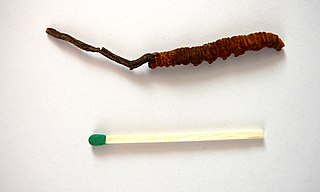
Ophiocordyceps sinensis, known colloquially as caterpillar fungus, is an entomopathogenic fungus in the family Ophiocordycipitaceae. It is mainly found in the meadows above 3,500 metres (11,500 ft) on the Tibetan Plateau in Tibet and the Himalayan regions of Bhutan, India, and Nepal. It parasitizes larvae of ghost moths and produces a fruiting body which is valued in traditional Chinese medicine as an aphrodisiac. Caterpillar fungus contains the compound cordycepin, an adenosine derivative. However, the fruiting bodies harvested in nature usually contain high amounts of arsenic and other heavy metals, so they are potentially toxic and sales have been strictly regulated by China's State Administration for Market Regulation since 2016.

Cordycepin, or 3'-deoxyadenosine, is a derivative of the nucleoside adenosine, differing from the latter by the replacement of the hydroxy group in the 3' position with a hydrogen. It was initially extracted from the fungus Cordyceps militaris, but can now be produced synthetically. It is also found in other Cordyceps species as well as Ophiocordyceps sinensis.
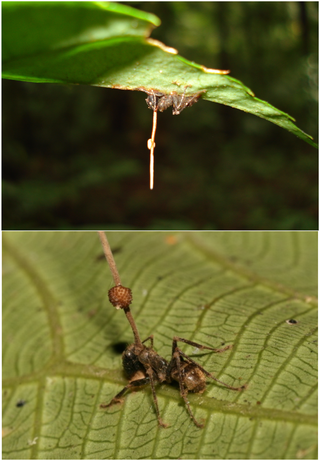
Ophiocordyceps unilateralis, commonly known as zombie-ant fungus, is an insect-pathogenic fungus, discovered by the British naturalist Alfred Russel Wallace in 1859, and currently found predominantly in tropical forest ecosystems. O. unilateralis infects ants of the tribe Camponotini, with the full pathogenesis being characterized by alteration of the behavioral patterns of the infected ant. Infected hosts leave their canopy nests and foraging trails for the forest floor, an area with a temperature and humidity suitable for fungal growth; they then use their mandibles to attach themselves to a major vein on the underside of a leaf, where the host remains after its eventual death. The process, leading up to mortality, takes 4–10 days, and includes a reproductive stage where fruiting bodies grow from the ant's head, rupturing to release the fungus's spores. O. unilateralis is, in turn, also susceptible to fungal infection itself, an occurrence that can limit its impact on ant populations, which has otherwise been known to devastate ant colonies.

Ophiocordycipitaceae is a family of parasitic fungi in the Ascomycota, class Sordariomycetes. It was updated in 2020.

Ophiocordyceps is a genus of fungi within the family Ophiocordycipitaceae. The widespread genus, first described scientifically by British mycologist Tom Petch in 1931, contains about 140 species that grow on insects. Anamorphic genera that correspond with Ophiocordyceps species are Hirsutella, Hymenostilbe, Isaria, Paraisaria, and Syngliocladium.
Podonectria is a genus in the monotypic Podonectriaceae family of fungi. They are parasitic fungus on scale insects, other fungi, or on substrates that had previously colonized by other fungi.
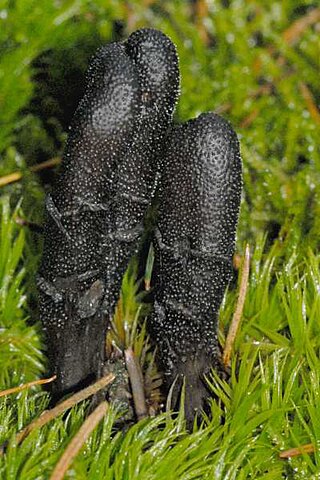
Tolypocladium is a genus of fungi within the family Ophiocordycipitaceae. It includes species that are parasites of other fungi, insect pathogens, rotifer pathogens and soil inhabiting species with uncertain ecological roles.
Thitarodes caligophilus is a species of moth of the family Hepialidae. It is found in Bhutan. It is a host of the entomopathogenic fungus Ophiocordyceps sinensis, a species of the genus Cordyceps. The fruiting bodies of Ophiocordyceps sinensis are used extensively in Traditional Chinese medicine. As a result, T. caligophilus-sourced Cordyceps harvested in Bhutan have become "widely used".
Ophiocordyceps myrmecophila is a species of fungus that parasitizes insect hosts, in particular members of the order Hymenoptera.
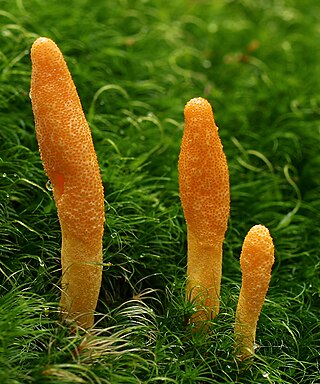
Cordyceps militaris is a species of fungus in the family Cordycipitaceae, and the type species of the genus Cordyceps, which consists of hundreds of species. The species was originally described by Carl Linnaeus in 1753 as Clavaria militaris. Cordyceps militaris parasitizes insects and is used use in traditional Chinese medicine and modern pharmaceuticals.

The Cordycipitaceae are a family of parasitic fungi in the Ascomycota, class Sordariomycetes and order Hypocreales. The family was first published in 1969 by mycologist Hanns Kreisel, but the naming was invalid according to the code of International Code of Nomenclature for algae, fungi, and plants. It was validly published in 2007.

Ophiocordyceps macroacicularis is an entomopathogenic fungus belonging to the order Hypocreales (Ascomycota) in the family Ophiocordycipitaceae, which parasitize moth larvae. It produces superficial, oval perithecia at the apex of its stroma, and also multiseptate ascospores, while producing Hirsutella-type anamorphs on growth culture media. They are particularly distinguished by the size and shape of their stromata.
Ophiocordyceps arborescens is an entomopathogenic fungus belonging to the order Hypocreales (Ascomycota) in the family Ophiocordycipitaceae. It produces superficial, oval perithecia at the apex of its stroma, and also multiseptate ascospores, while producing Hirsutella-type anamorphs on growth culture media. They are particularly distinguished by the shape and size of their stroma.
Ophiocordyceps coenomyia is an entomopathogenic fungus belonging to the order Hypocreales (Ascomycota) in the family Ophiocordycipitaceae. It is parasitic to awl-fly larvae. This species is characterized by a globose, alutaceous fertile part at the apex of its light yellow stroma, its immersed perithecia, and ascospores dividing in turn into partspores. The species is closely related to O. heteropoda.

Ophiocordyceps formicarum is an entomopathogenic fungus belonging to the order Hypocreales (Ascomycota) in the family Ophiocordycipitaceae. The fungus was first described by mycologist George S. Kobayashi in 1939 as a species of Cordyceps. Originally found in Japan growing on an adult Hercules ant, it was reported from Guizhou, China, in 2003. It was transferred to the new genus Ophiocordyceps in 2007 when the family Cordycipitaceae was reorganized. A technique has been developed to grow the fungus in an agar growth medium supplemented with yeast extract, inosine, and glucose.
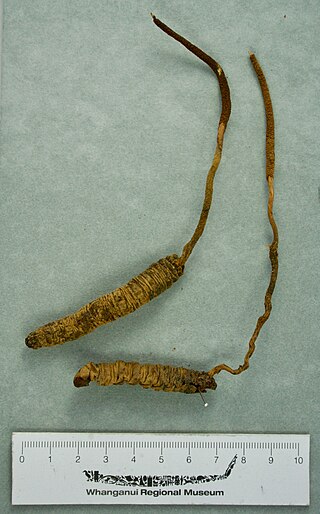
Ophiocordyceps robertsii, known in New Zealand as vegetable caterpillar is an entomopathogenic fungus belonging to the order Hypocreales (Ascomycota) in the family Ophiocordycipitaceae. It invades the caterpillars of leaf-litter dwelling moths and turns them into fungal mummies, sending up a fruiting spike above the forest floor to shed its spores. Caterpillars eat the spores whilst feeding on leaf litter to complete the fungal life cycle. Evidence of this fungus can be seen when small brown stems push through the forest floor: underneath will be the dried remains of the host caterpillar. This species was first thought by Europeans to be a worm or caterpillar that burrowed from the top of a tree to the roots, where it exited and then grew a shoot of the plant out of its head. It was the first fungus provided with a binomial name from New Zealand.

Cordyceps locustiphila is the basionym and teleomorph of the fungi Beauveria locustiphila, a species of fungus in the family Cordycipitaceae. and is a species within the genus Cordyceps. It was originally described in by Henn in 1904. C. locustiphila is an entomopathogen and obligate parasite of the grasshopper species within the genus Colpolopha or Tropidacris, and as such is endemic to South America. The scientific name is derived from its close relationship with its host, being named after locusts. The fungi was renamed to Beauveria locustiphila in 2017 following research into the family Cordycipitaceae. Following the loss of the species type specimen, new studies were conducted that now recommend that the fungi be divided into 3 species. C. locustiphila, C. diapheromeriphila, and C. acridophila.

Cordyceps gunni is a species of fungus in the family Cordycipitaceae, and is of the genus Cordyceps. It was originally found and recorded by Gunn in Tasmania and named as Sphaeria gunnii and later moved into the Cordyceps genus and renamed Cordyceps gunnii. This fungus and its sisters in the genus Cordyceps are known for growing out of insect bodies. C. gunnii can be found at ground level poking out of caterpillar burrows, attached to a caterpillar's head.

Isaria cicadae is an ascomycete fungus that parasitizes cicada larvae. It forms white and yellow asexual fruiting structures resembling synnema. While mostly being found throughout Asia in warm, humid regions, it has been found on various other continents. It is known in Traditional Chinese Medicine as Chan Hua and commonly called “cicada flower.” Its medicinal uses date back to the fifth century AD in China. It can also be used in various foods and tonics.

Ophiocordyceps dipterigena is an entomopathogenic fungi species from the genus Ophiocordyceps. This species was originally described in 2007.

















